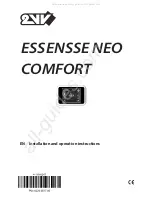
AN83REV1
45
CS8900 Technical Reference Manual
2.4.3 Routing of the digital signals
Most of the digital signals from the
CS8900 go to the ISA bus connector.
Route these signals directly to the connec-
tor. Isolate the digital signals from analog
signals.
2.4.4 Routing of the analog signals
Routing of the clock signals: Place the
20.000 MHz crystal within one inch of
XTL1 (pin #97) and XTL2 (pin #98) pins
of the CS8900. The 20.000 MHz crystal
traces should be short, have no via, and run
on the component side.
Biasing resistor at RES pin of the CS8900:
A 4.99 K Ohm resistor is connected be-
tween pins RES (pin #93) and AVSS3 (pin
#94) of the CS8900. This resistor biases
internal analog circuits of the CS8900, and
should be placed as close as possible to
RES pin (pin #93) of the CS8900.
Routing of the 10BASE-T signals: Four
signals are used for 10BASE-T communi-
cation, two differential transmit signals and
two differential receive signals. An isola-
tion transformer is placed between the
transmit and receive traces and a RJ-45
(modular phone jack) connector. The iso-
lation transformer should be placed as close
as possible to the RJ-45 connector. Both
transmit and receive signal traces should be
routed so they are parallel and of equal
length. The signal traces should be on the
component side and should have direct and
short paths. The widths of the receive sig-
nal traces should at least be 25 mil. while
widths of the transmit signal traces should
be at least 100 mil. This will provide a
good impedance matching for the transmit
and receive circuitry inside the CS8900. A
ground trace should be run parallel to the
transmit traces. Also, a ground plane
should run underneath the transmit and re-
ceive traces on the solder side of a two lay-
ered PCB. Please refer to the Figures
2.4.12 and 2.4.13 for illustration of the
above guide lines.
Routing of the AUI signals: The CS8900
has three pairs of differential signals con-
necting it to an Auxiliary Unit Interface
(AUI). An isolation transformer separates
the three signal pairs and the AUI connec-
tor (a 15 pin sub-D connector). The isola-
tion transformer should be placed as close
as possible to the AUI connector. Signal
traces of each differential pair should be in
parallel with equal length and impedance.
Thus minimizing differential noise due to
impedance mis-match. Place the AUI sig-
nal traces on the component side.
Содержание CRYSTAL LAN CS890
Страница 26: ...26 AN83REV1 CS8900 Technical Reference Manual Figure 2 2 9 CRD8900 Top Side Routing ...
Страница 27: ...AN83REV1 27 CS8900 Technical Reference Manual Figure 2 2 10 CRD8900 Bottom Side Routing ...
Страница 36: ...36 AN83REV1 CS8900 Technical Reference Manual Figure 2 4 2 Ground connection Top layer of two layer Combo Card ...
Страница 40: ...40 AN83REV1 CS8900 Technical Reference Manual Figure 2 4 6 Component top side of four layer board ...
Страница 41: ...AN83REV1 41 CS8900 Technical Reference Manual Figure 2 4 7 5V Plane of four layer board ...
Страница 42: ...42 AN83REV1 CS8900 Technical Reference Manual Figure 2 4 8 Ground Plane of four layer board ...
Страница 43: ...AN83REV1 43 CS8900 Technical Reference Manual Figure 2 4 9 Solder side bottom of four layer board ...
















































